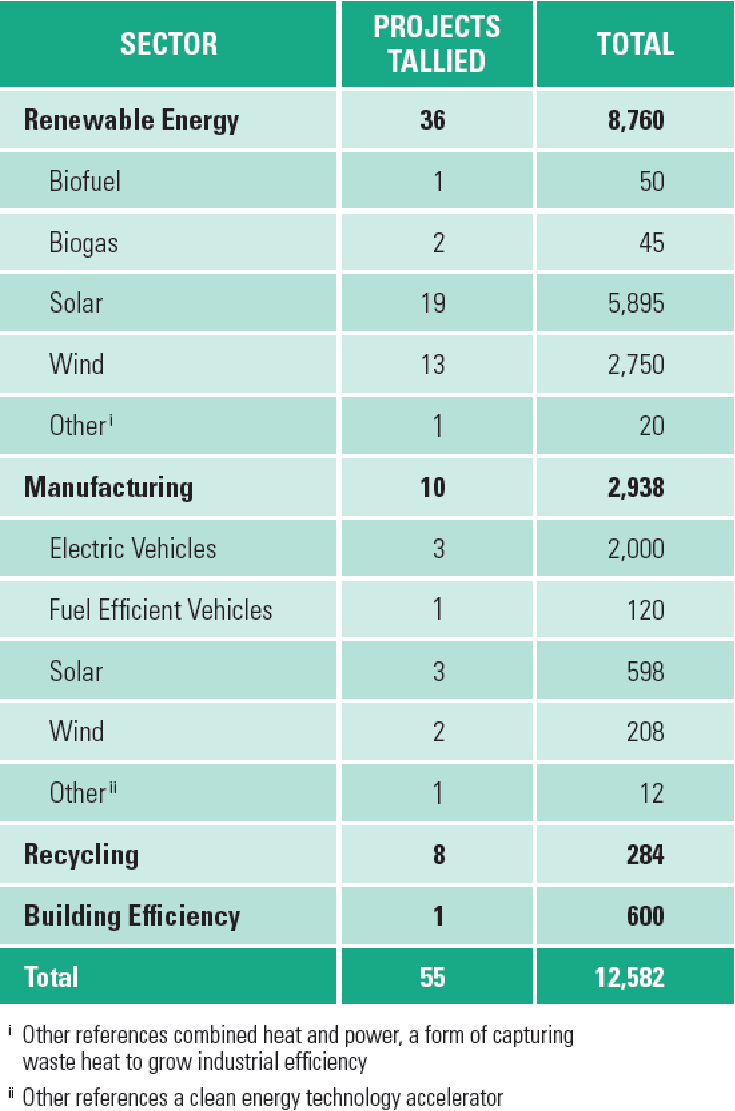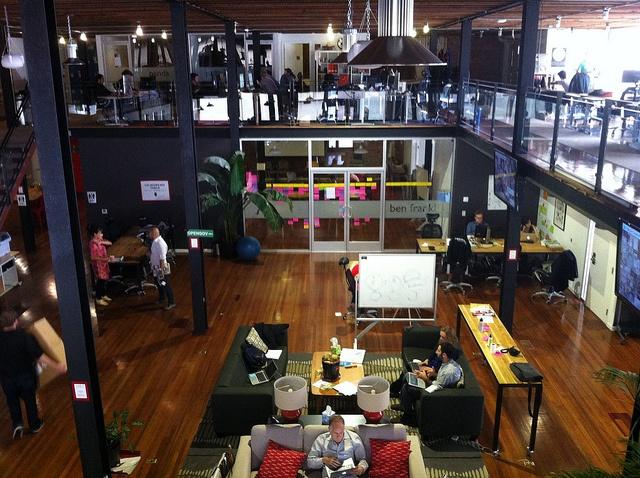Green Job Openings More Than Double in the Second Quarter of 2014


More than 12,500 clean energy and transportation jobs were announced in this year's second quarter (Q2 2014), more than double that of Q1, according to a report from Environmental Entrepreneurs (E2) on the eve of the Labor Day weekend.
The announcement of the Obama administration's Clean Power Plan instilled confidence and greater certainty regarding the future of clean energy in the U.S. That, in turn, helped spur the jump in clean energy job announcements in Q2, Environmental Entrepreneurs stated in a press release.
“This Labor Day weekend, the story is that more Americans are working because of clean energy,” E2 Executive Director Bob Keefe was quoted as saying. “But to keep that growth going, we need our state and federal leaders to do their jobs too. We need them to support smart policies that grow our economy and protect our environment – policies like the federal Clean Power Plan.”
Clean energy, transportation policies spur green job creation
Jonathan Foster, CEO of energy software services company Nexant and director of E2's Northern California chapter, highlighted the pivotal role government policy plays in establishing the rules governing a private-sector, market-driven economy that values both environmental and economic sustainability:
“Businesses depend on market certainty, and clean energy businesses are no different. What good policies do – whether it’s AB 32 in California or the new federal Clean Power Plan – is help create market certainty. That’s good for our economy and our environment.”
Green job growth leaders
Examining Q2 growth in clean energy and clean transportation job announcements across the nation, E2 found that more were announced in Arizona than any other U.S. state. California ranked second and Michigan third.
“Solar Wind Energy Inc. announced it expects to hire at least 350 permanent jobs for a new project in San Luis, Arizona. California ranks second in the E2 report, thanks to announcements from the utility-scale solar industry and from 500 new jobs announced by Tesla Motors. Michigan placed third, with GM expected to add as many as 1,400 jobs producing advanced battery technologies,” E2 elaborated.
In its press release, E2 also summarized other notable clean energy projects announced across the U.S. during th second quarter:
- Well over 1,000 new jobs stemmed from SolarCity’s announcement of its $200 million acquisition of solar manufacturer Silevo. As part of the acquisition, SolarCity will build a 1 GW annual production capacity manufacturing facility at the RiverBend clean energy hub in Buffalo, New York;
- 800 new construction jobs tied to Tenaska’s recently-closed deal to build the Imperial Solar Energy Center West Project in Imperial County, California;
- 800 jobs created with the $66.7 million investment from Boston Housing Authority, which enabled public housing water and energy retrofits throughout the city. The city expects to save $4 million a year.
For five quarters running, more solar energy jobs were announced (22) in Q2 than were announced in any other clean energy or clean transportation sector, E2 found. “[F]ive solar companies announced hiring in the residential sector, expanding their existing workforce in the prime solar markets of Arizona, California, New York and Massachusetts. Each of these states has strong net metering policies, enabling residents to sell electricity back to the grid,” E2 highlights.
The complete report is available free for downloading on the E2 website.
Image credits: Environmental Entrepreneurs, "Clean Energy Works For Us: Second Quarter 2014 Report"
The Value of Bike Sharing: Looking Beyond Carbon Emissions


While the sharing economy fan base continues to expand, questions rise about the true economic and social impacts of sharing.
Interestingly, one part that is still missing from these discussions (well, not entirely) is the environmental impacts of the sharing economy. The general notion is that the sharing economy has a positive environmental impact as it promotes a greater use of underutilized assets. But is this true?
This answer no doubt is complicated. There are even doubts about the environmental impacts of first appears to be one of the greener parts of the sharing economy – bike sharing.
As Bobby Magill reported recently on Climate Central, while we know for sure that nobody has ever died on a bike-share bike, we can’t really be sure what impact bike sharing has on climate change.
It’s not that we don’t know that riding a bike is better for the climate or that we can’t quantify it – “Each mile someone rides on a bike-share bike instead of driving a car means about one pound of carbon dioxide is kept out of the atmosphere,” according to Dr. Susan Shaheen. The problem is that we don’t know for sure how many people ride a bike as an alternative to driving a car and that the data varies greatly from city to city. However, the estimate is that on average less than 20 percent of the riders switch from cars, according to Prof. Ralph Buehler.
Now, is it really that important to know how many riders use the bike instead of a car? Theoretically yes, because the environmental impact is more significant if you use a bike-sharing service as an alternative to driving your car compared to using it instead of using public transit. However, practically, it doesn’t seem to matter that much.
Why? Let’s see the numbers.
So far, more than 23 million bike trips were made in the U.S. with bike-sharing services. To calculate how many miles these trips covered we’ll use information from B-Cycle, the company that designs the bike-sharing systems used in most cities across the U.S. According to Climate Central, the company claims that 2.1 million bike trips covering 4.5 million miles have been made on all of its systems since 2010 -- or, in other words, 2.14 miles per trip. Looking at New York Citibike’s latest data from April (1.07 mile per ride) and May 2014 (1.8 miles per ride), the B-Cycle figure seems pretty conservative.
If you multiply 23 million rides at 2.14 miles per ride, you get 49.22 million miles. Using Dr. Saheen’s estimate of one pound of carbon dioxide that is kept out of the atmosphere for every mile someone rides a bike instead of using their car, we could say that -- if all 49.22 million bike-miles were an alternative to car-miles -- then bike-sharing systems have saved 22,326 metric tons of C02 so far.
Is this impact significant? Not really. Using data from the EPA and the Union of Concerned Scientists, I’ve calculated that even if all of the 23 million rides were an alternative to car-miles it would offset only 10 minutes of car- and light truck-driving in the U.S. (2012 data).
So, does this mean that bike-sharing programs are not as green as we might assume? Well, not so fast.
“The ultimate goal of public bike sharing is to expand and integrate cycling into transportation systems, so that it can more readily become a daily transportation mode (for commuting, personal trips, and recreation),” Dr. Shaheen an three other researchers write in a study published in 2012 (Public Bikesharing in North America: Early Operator and User Understanding).
I believe the authors are right. Rather than looking at bike-sharing systems through the narrow lens of their direct impact on climate change, health, traffic congestion or even environmental awareness, we should use a much broader framework when evaluating their impact and value: city residents’ well being.
What I mean is that the main 'green' challenge bike-sharing programs address is not necessarily climate change but mobility in cities. “Of every one hundred American commuters, five take public transit, three walk and only one rides a bicycle to work or school,” Charles Montgomery writes in his book “Happy City.”
Montgomery notes that it’s no coincidence that even in dense, connected American communities very few people use bikes, which “is rated the most fun, efficient and joyful” travel mode. The reason, he explains, lies in the intersection between psychology and design. In other words, our travel choices are greatly influenced by the way cities are designed and the perception we have of different travel modes. In both cases, bikes seem to be in a disadvantaged position compared to all other modes of transportation; American cities are not designed with bikes in mind, and many people don’t think of biking as a joyful, efficient, convenient and safe choice.
This is where bike-sharing programs can make a difference. We should look at them as an intervention aimed to change the dynamics of mobility in cities, making bike riding more accessible, safe and desirable, and thus increasing residents’ well being.
Looking at these criteria, I believe so far bike-sharing programs perform pretty well. They provide a relatively affordable access to bike riding without the need to own a bike (a product service system); they increase riders’ safety as a greater presence of bikes forces motorists to drive more carefully (and thus “the cities with the largest share of cyclists have the fewest cycling fatalities”); and finally, they also seem to help improve the image of cycling.
So, when it comes to how green bike-sharing programs are, the focus should be their well-being impact, not their climate impact. The framework for this discussion should be urban mobility, not carbon emissions, and it’s true not just in terms of having the right discussion, but also in terms of communicating this issue. After all, what would get people more excited about bikes – knowing that they will save X metric tons of carbon emissions or that their rush-hour might look like this?
Image credit: Steven Rhodes, Flickr Creative Commons
Raz Godelnik is an Assistant Professor of Strategic Design and Management at Parsons The New School of Design. He lives in Brooklyn and likes to ride his own bike. You can follow Raz on Twitter.
Millenial Voices: Navigating the Intersection of Race, Sexuality and Profession


Editor’s Note: This article originally appeared in “The Millennials Perspective” issue of Green Money Journal. Click here to view more posts in this series.
By Julius Tapper
As you may have noticed, there's a theme to this issue of GreenMoney. As I write this article, featured as a "millennial voice," I can't hide a small smirk of irony. I grew up hating labels. Or, more diplomatically put, I had a strong aversion to them – especially my own. As a kid, my labels made me uncomfortable; black, gay, nerd. By definition, they were accurate, but they didn't seem to fit. They felt limiting and prescriptive; they came with baggage that wasn't my own. I felt my individuality, my identity, was undercut by my group affiliations.
My perceived stereotypes of “gay” and “black” were incongruent with my desire to be socially accepted and professionally successful. Inhabiting my intersection of race and sexuality was also difficult; Jamaica (where my parents are from) has a notoriously homophobic culture. In response to the tension between my identities, I retreated from them. When I stopped running from – and turned to examine – my ascribed labels, I found community, culture, and stories with personal resonance. I came to acknowledge that my individuality is enhanced by the intersectionality of my identities, and the history they bring. Frankly, I'm now quite proud of my labels, and they are an active and living part of who I am. Maya Angelou's recent passing, for me, reinforced one of her most poignant lessons: "I go forth alone, and stand as ten thousand," and I call on those tribes often.
Having been called on as a millennial to share my story for this article, I'm a little less suspicious of the label, and a little more interested in exploring what it means to me and what it might mean for the investment community. All of this talk of identity may seem a little sentimental for an investment publication, but I argue that identity will be a critical consideration for the investment community going forward.
We millennials have experienced a lot in our short lives. As Jed Emerson and many others have noted: "[We] have experienced major boom and bust periods, including the prosperity of the 1990s dot-com frenzy, and the financial markets’ collapse in 2008 and subsequent recession … [We] witnessed 9/11, the Arab Spring, long wars in Iraq and Afghanistan, multiple terrorist attacks, and dramatic political division…" I'll throw in climate change for good measure. Amid this external turbulence and uncertainty, the existential "quarter-life crisis" is a cultural trope of the millennial generation.
I expect a lot of change in my life. For me, the search for stability turns inward, trying to sort out conceptions of meaning, purpose and values to distill some sort of personal terra firma. Though this exercise is self-reflective, it is also social. My most memorable and engaging conversations have often been about these issues. It's also interesting to note how often these abstract conversations become very concrete. What do I want from my career? How do I want to spend my time and energy? How do I want to invest my resources?
In 2009, I started my career at TD Securities, TD Bank Group’s capital markets division. It was a dynamic time to begin my training as a banker. Not only were regulations changing, but also expectations; how could the industry be different, how could it be better?
After three years in traditional finance, I was looking for something different from my career. Here, my identity played a pivotal role in my career trajectory. On May 17, 2012, TD launched its "It Gets Better" video contribution to combat homophobia. TD strives for a culture where you are encouraged to bring your full authentic self to work; the video brought this to life for me in a very visceral way (read tears). I appreciated the power of bringing yourself to work, but it also drove me to bring my full self to my work. I wanted to carry personal authenticity and alignment across my life, and I wanted to make intentional decisions in pursuit of those ends. For me, it was the decision to make a transition to a career more focused on 'impact' – positive social and environmental outcomes.
Read the complete article here.
Julius Tepper is Manager of Social Finance at TD Bank Group, where he is leading the development of TD’s social finance and impact investing strategies, recently coordinating the launch of TD’s inaugural $500 million Green Bond. Julius also helps manage TD’s venture philanthropy and financial literacy initiatives. You can find Julius on Twitter @juliustapper.
Taking Sustainability Beyond the Company Walls


A thoughtful article in the Economist suggests we should be more rigorous with the meaning of 'sustainability' in the corporate world, granting it to the broad efforts undertaken by companies like SABmiller and Unilever.
What many companies call 'sustainable' measures should be more succinctly termed 'efficiency' measures ... which, if we really think about it, is what corporations should be doing anyway in the name of just straight-up economic principles. If producing less waste, using less packaging, putting up solar panels and reducing energy use with LED lights is 'sustainable,' then of course companies that do this will see a return. Of course they will!
However, the jury arguably is still out on broader, more aggressive moves toward social and environmental responsibility. But companies like SABmiller are undertaking the Big Experiment.
SABmiller is the second largest brewer in the world. Here in North America we're familiar with the company through products such as Leinenkugel, Molsen, Miller Genuine Draft and Miller Lite. And of course the next time you poo-poo that 40-ounce bottle of Olde English 800, just know that the company producing it is personally bringing experts and facilities to wheat farmers in Rajasthan in northern India to help them reduce water draw from the strained aquifer by 23 percent and water runoff by 40 percent. The company is also increasing its focus on its own customers with road-safety and anti-drunkenness campaigns.
The difference between SABmiller's approach and other company-centered 'efficiency' efforts is the depth of focus outside the company's own walls. A business can say "we reduced our water use" or "we have reduced our carbon footprint" or even say "we don't use child labor" but refer only to what is directly from their own operations, which tends to be comparatively small.
The larger environmental and social impacts are often found in the sprawling supply chain and in consumer use.
According to Jane Nelson, director of the Corporate Social Responsibility Initiative at the Harvard Kennedy School, the broader view of social and environmental responsibility is part of a growing trend among businesses.
But therein we find the aforementioned problem: It's still unclear if there's a long-term economic benefit to doing business this way. Yes, the first movement toward sustainability helped businesses reduce their costs by way of creating greater efficiency. But will that be so with more diligent attention and action outside the company walls?
In SABmiller's case the cost of their sustainability efforts, such as teaching basic business skills to a half a million entrepreneurs, may turn out to eclipse the economic benefit. If so, then a broader focus on the social good could conceivably make responsible products more expensive and simply turn people toward the cheaper, more harmful competitor.
However, we're clearly not dealing with idiots here. The companies embracing broader, more socially responsible activities certainly have the long-term in mind, whether it's preparing their companies for future legal requirements, staving off government oversight, or simply creating a world where their product is still viable and people can still afford to buy it. We'll see in the coming decades what comes of these truly 'sustainable' practices.
Image credit: karlnorling - Source
Despite Bully Tactics, We Can’t Stop Using Uber


Nobody likes a bully. Nowhere in the world is this truer than in the United States, a nation which was founded on the notion of standing up to bullies. We disdain an unfair fight and often find ourselves rooting for the underdog. We are taught since kindergarten to believe that we ought to treat others the way we wish to be treated -- and that the one most hurt by bullying is the bully himself.
Tell that to Uber, which has made little effort to shroud its back-handed tactics to annihilate its ridesharing competitors, namely Lyft. Earlier this year I likened Uber to the Galactic Empire of Star Wars and Lyft to the underdog Rebel Alliance. Leveraging a war chest which now has grown to some $1.5 billion dollars, Uber has done whatever it can to put Lyft down — from gimmicky marketing schemes and attack ads, to even lowering rates.
But all of that seems paltry in comparison to Uber’s latest anti-Lyft strategy, which has devolved into outright sabotage. According to the Verge, Uber is hiring teams of independent contractors equipped with burner phones and credit cards as part of a sophisticated effort to undermine Lyft and other competitors. The contractors, which Uber calls “brand ambassadors," are paid to requests rides from Lyft and other competitors in an effort to recruit their drivers — all the while taking multiple precautions to avoid detection.
Well, they didn’t go undetected. According to CNN Money, Lyft claims that 177 Uber employees have ordered and cancelled about 5,560 rides since October 2013. One brand ambassador allegedly created as many as 14 different accounts in order to perform 680 cancellations. Lyft drivers also have complained about being propositioned to join Uber.
Lyft discovered this after cross-referencing the phone numbers used in the faux requests and finding links to Uber recruiters. Though Uber issued an apology earlier this year after documents surfaced showing a similar scam reported by Valleywag and TechCrunch, this time the company has stayed silent.
Sorry not sorry, as they say.
Uber is calling this effort Operation SLOG (Supplying Long-term Operations Growth), which already has resulted in thousands of canceled Lyft rides and made it more difficult for its largest competitor to establish a foothold in new markets. However, Uber claims Lyft’s accusations were “baseless and simply untrue," arguing that Lyft has carried out similar call-and-cancel strategies.
"We never use marketing tactics that prevent a driver from making their living — and that includes never intentionally canceling rides," Uber wrote in a blog post.
But Lyft is not the only Uber competitor to complain — GetTaxi, a ridesharing service available in such cities as New York, London, Moscow and Tel Aviv, told Business Insider that Uber employees had called and cancelled rides from the company during a two-week period in January and February of this year.
Uber’s business practices seem counter to everything that the sharing economy stands for: community, trust and magnanimity. But the company is banking on the idea that people are pragmatists. In other words, that people could care less if it is their personal driver or friend with a car (Uber and Lyft’s mantras, respectively), as long as they can get the quickest, easiest and cheapest ride possible.
So far, Uber seems to be correct. Though Lyft’s coverage capacity in many big markets, such as San Francisco, are on par with Uber’s, this is not the case in other important battleground markets. In Washington, D.C., for example, I have noticed that while I typically can find an Uber within two minutes, it can take as long as six minutes to secure a Lyft ride. For many consumers, that four minutes can be the difference between accepting or canceling a ride. Even those who would prefer to take a Lyft will opt for an Uber if they can’t find a Lyft quickly enough.
Even as Uber continues its Machiavellian march towards outright ridesharing monopoly, it is also adding some pretty cool services, such as partnering with United Airlines to integrate Uber services with the airline’s app. The company also seems content to go it alone in fighting policymakers and taxi regulators, who would like nothing more than to see Uber, Lyft, Sidecar and every other transportation network company (TNC) go the way of the dodo.
Uber may be a bully, but boy are they killing it. For now.
Image Credit: Flickr foxmental
Based in Washington, D.C., Mike Hower is a writer, thinker and strategic communicator that revels in driving the conversation at the intersection of sustainable business and policy. He has cultivated diverse experience working for the United States Congress in Washington, D.C., helping Silicon Valley startups with strategic communications and teaching in South America. Connect with him on LinkedIn or follow him on Twitter (@mikehower)
Passive House Standard Results in Energy and Cost Savings


While typical homes of a comparable size require families to spend several thousand dollars each year on heat alone, my family of four in Midcoast Maine spent less than $120 a month last winter on of all our utilities, including heat and hot water. On cold, windy days, our home has no drafts. During sunny winter days, our home is heated exclusively by solar gains, and the heating system doesn’t turn on for many hours. Despite having no air conditioning, our home is comfortable throughout the summer. The secret is that we live in a home at Belfast Cohousing & Ecovillage, a 36-unit community constructed to the Passive House standard (although it was not certified).
Homes built to the Passive House standard use a mere 10 percent of the energy for heating and cooling that a code-built home does. For every $1 our neighbors pay to heat their homes, we pay only 10 cents. Generous quantities of insulation in the foundation, walls and roof; a solar orientation; exceptional ventilation; triple-pane windows and doors; an airtight envelope; lots of southern glazing; and thermal mass in the slab have resulted in exceptional comfort and very low utility bills.
The super energy efficient features of our home begin in the foundation, with a layer of rigid foam between the cement slab and the ground. The slab stores passive solar heat during winter days and slowly releases it into the home at night (when the ambient temperature is lower). The walls are constructed with a layer of SIPs (structural insulated panels), which contain a foam core, resulting in continuous insulation that prevents heat from leaking out. Blown-in cellulose is added to the walls and ceiling, and we have a standing seam metal roof, a durable and energy-efficient alternative to roof shingles.
Such a home would not have healthy indoor air if it weren’t for our Zehnder heat recovery ventilation (HRV) system. In our house, stale air is removed from the kitchen and bathroom, with fresh air supplied to the bedrooms. This prevents moisture issues and boosts air quality without compromising efficiency. At the same time, heat is transferred from the outgoing air to the incoming air, preventing heat loss. Zehnder’s HRV systems are up to 95 percent efficient.
As a result, our home does not have bathroom exhaust fans or a vented hood over the range because these would vent warm air out of the house without capturing the heat. If we wish to remove odors, fumes, smoke from cooking or condensation after showering, we can temporarily boost the HRV system.
Triple-pane Unilux windows and doors complement the HRV system and the super insulation. Even with subzero temperatures on windy nights, I felt no drafts when sitting in front of the windows, partly because of the airtight seal. The windows can swing inward on two hinges or tilt inward to open at the top. The latter offers draft-free ventilation, prevents rain from entering the home and is safe for children.
Passive House builders go to great lengths to air-seal the homes, caulking and taping the SIPs together and applying housewrap to the exterior. The result is a virtually airtight home. A blower door test was performed on all Belfast Cohousing & Ecovillage homes, with all of them showing below 0.60 air exchanges per hour at 50 Pascal pressure, as specified in the Passive House standard. This is a measure of how many air changes take place in the house in one hour, so a lower number indicates that a home is more sealed to the outside. Because our home is virtually airtight, an HRV system is necessary to ensure high-quality air and avoid moisture problems in our cold climate.
The southern glazing on the home allows the heat of the sun to gradually warm our home. We are diligent to not block the winter sun with curtains or foliage. If we set our thermostat to 65 degrees Fahrenheit, the home will often reach the upper 70s on a sunny day without the heating system turning on. The southern windows also bring lots of natural light into our home, helping to prevent winter doldrums and providing scenic views.
When the home heats up, warmth is stored in the cement slab. When the indoor temperature starts to drop, the heat from the slab is slowly released, helping to stabilize the temperature. On many sunny winter days, our heating system didn’t turn on until well into the night.
During a five-day power outage last December, we had a chance to really see how our home would perform. Would we need to stay with friends or in a hotel until it passed? Despite below-freezing temperatures and mostly overcast weather throughout, our home lost only 2 degrees a day. When my husband and kids did jumping jacks, they could warm a room by a couple of degrees.
The North American Passive House Network 2014 Conference & Expo is coming up on Sept. 22 and 23 in Portland, Maine. It’s a great opportunity to learn more about high-performance buildings and the tools and methodologies behind them.
Image credit: Jeffrey Mabee of Belfast Cohousing & Ecovillage
Sarah Lozanova is a regular contributor to environmental and energy publications and websites, including Mother Earth Living, Green Building & Design, Home Power, Urban Farm, and Solar Today. Her experience includes work with small-scale solar energy installations and utility-scale wind farms. She earned an MBA in sustainable management from the Presidio Graduate School and she resides in Belfast Cohousing & Ecovillage in Midcoast Maine with her husband and two children.
The Online Artisan Marketplace: A Huge Boost for Handmade Products


Published earlier today on Triple Pundit.
At a first glance, it is easy to lament both the decline of the small store and the artisan marketplace in North America, as big-box stores have redefined conventional and online shopping. E-commerce behemoths such as Amazon, where one can buy anything from dog food to king-sized beds, have also done a number on small goods. Plus, the rise of China as the world’s factory hardly helps the cause of the small shopkeeper or artisan.
All of this has been on my mind while I’m spending some time in Montevideo, Uruguay, where it is easy to avoid the malls and hypermarkets: There is something to be said about going to five or 10 different businesses while walking to do errands, from the laundry service, to the cheese store, to the vegetable stand, to finally the kiosk to recharge my phone. Living here, it would be easy for me to change my profile picture to that icon, “I didn’t buy it on Amazon.”
At the same time, however, the Internet has made it far easier for artisans, artists, and craftsmen and women to highlight and sell their wares. The creative types who have long been priced out of neighborhoods, such as Williamsburg in Brooklyn or Fillmore in San Francisco, can open a store, online, with no overhead. And for their customers, while the experience may not be as social, or convivial, as walking from store to store, finding that perfect item can be rewarding as he or she bypasses Amazon, Walmart.com or the other online giants. The result is a welcome trend for handmade goods.
Take a look at Etsy, the e-commerce site focused on vintage, handmade or, as the popular saying goes, artisanal products. Founded in 2005, Etsy stands out among Internet companies for the fact that it makes money (profitable since 2009) and is actually wildly successful. In 2013, sales of merchandise passed $US 1 billion for the first time, in part because of the sharp rise of consumers shopping on their mobile phones. On the business side, its growth and business approach are similar to other Internet companies: acquisitions, muscling in on policy when it can, and embracing new consumer trends and technology. And on the social side, Etsy does what it can to train potential sellers, which helps the un- or under-employed boost their financial prospects while adding to the company’s bottom line in the long run. The result is an online open market where 1 million vendors pitch 26 million products between 200 nations and territories.
Etsy’s growth has occurred in part because of how seamless it is to sell products on the company’s site. Etsy charges 20 cents for each item and takes only a small cut of the sales — eliminating the headache of expensive rents and, in many cities, greedy landlords. So anyone from a central California artist to a vintage maven in North Carolina can run a business out of a home or studio — and either make it a full-time job or a way to source some extra cash. As a result of the possibilities Etsy and its competitors have fostered, publications from Forbes to the Harvard Business Review has touted the ties between 21st century technology and 19th and 20th century crafts.
Not everyone is praising the re-emergence of artisanal goods, however. One Australian report actually suggested that a focus on such products can actually be a drag on the economy, citing the example of consumers’ increased demands for “handmade bread” and similar products. That probably has a degree of truth when considering productivity as part of classical economic theory, but in the end, the rise of more handmade goods offers far more benefits in the long run. The reality is that handmade soaps, sweaters and ceramics will never displace what is coming out of Asian factories to suburban, and now increasingly urban, big-box stores. Instead, they look to be a complement for the foreseeable future, and if this means more people can contribute to the economy, rather than being excluded from it because the alternative is working low-wage jobs, all of us will benefit.
Image credit: Leon Kaye
Leon Kaye has lived in Abu Dhabi for the past year and is currently spending some time in Uruguay. Follow him on Instagram and Twitter. Other thoughts of his are on his site, greengopost.com.
Ford extends community links with free training programme


Car maker Ford's Driving Skills for Life, a free training programme for inexperienced drivers who have recently passed their driving test, gets into gear in the UK later this month, following a 10-year run in the US and a successful launch across Europe last year.
The training programme highlights some of the dangers new drivers are exposed and how they can be minimised. This includes using a mobile phone at the wheel, managing emergencies and night and wet-weather driving. Ford research recently found that one in three young Brits have taken a ‘selfie’ while driving, and that one in four have visited or posted an update on social media sites.
In addition, Ford provides a specially-developed ‘Drink Driving Suit’, consisting of weights with pads to restrict movement, headphones to distort hearing and ‘beer goggles’, all of which replicate the effects of driving whilst under the influence of alcohol.
The programme is run in partnership with the Automobile Association (AA) and the Royal Society for the Prevention of Accidents (RoSPA) kicks off in Scotland at the Silverburn Shopping Centre in Glasgow from 18th to 20th September. The second venue is the Heritage Motor Centre motor museum in Gaydon, Warwickshire, (4-5 October), before the programme moves south to Chobham, Surrey (7-9 October).
Health Care Savings Will More Than Cover the Cost of Reducing Emissions


People, primarily skeptics, often want to know what is the business case for taking action on climate change. Typically, all they can see is the prospect of energy prices going up since, they imagine, energy companies will be forced to make expensive modifications or pay taxes or credits that will raise the price of everything else while providing nothing additional in return. My favorite answer to the question is this one: What is the business case for not taking action? But recently I discovered another set of numbers that justify taking action, which leads me to believe there are probably even more waiting to be discovered.
Consider this: A cost-benefit study conducted by a team of MIT researchers and published in the journal Nature Climate Change looked at three different climate intervention scenarios, taking into account the health care cost savings. What they saw was that in one scenario, the health care cost savings achieved were actually ten times greater than the cost of implementing the scenario. In fact, in two of the three scenarios, the savings achieved by reducing the need for health care, avoided hospital visits, and decreased incidence of pollution-related illnesses more than covered the cost of the program.
The three scenarios selected were a clean energy standard, a policy aimed specifically at emissions from transportation, and a cap and trade program. What the researchers found was the following:
| Scenario | Cost | Health Care Savings |
| Clean Energy Standard | $208 billion | $247 billion |
| Transportation Emissions | ~$1000 billion | $260 billion |
| Cap and Trade | $14 billion | $147 billion |
What’s interesting about these results is that while the policies that were put forth in this study were developed to reduce CO2 emissions, it was several other emissions that co-exist with CO2 in fossil fuels exhaust streams, namely ground level ozone and fine particulates that yielded these health benefits when substantially reduced. Both of these pollutants can cause asthma as well as heart and lung disease.
These pollutants are quite common around the world. The US EPA’s standard for ozone was exceeded by 231 countries in 2011. Similarly, the standard for fine particulates was exceeded by 118 countries. Considering that the US, with relatively clean air achieves these benefits, imagine how effective these actions could be around the world.
By and large, this represents low-hanging fruit. The policies needed to substantially mitigate climate impacts would need to go further than this, to a point where health care savings would begin to see diminishing returns as air quality improves. But taking this level of action, considering that it already pays for itself, should be a no-brainer.
The other point worth noting is that if our health care costs weren’t so horrendously high, the savings achieved here would be less, though solving that problem doesn’t seem to be any easier than this one.
So here’s the problem. If you’re an oil company, you’re thinking that saving health care costs is a good thing, but not if I’m spending more to achieve it, and it’s not putting any more money in my pocket. This is where we need to change the system to one that recognizes that we are all in this together. The savings should be reflected back to those who took action, or made sacrifices to achieve them. That way nobody loses and everyone wins.
Image credit: Farangrakthai.com: Flickr Creative Commons
RP Siegel, PE, is an author, inventor and consultant. He has written for numerous publications ranging from Huffington Post to Mechanical Engineering. He and Roger Saillant co-wrote the successful eco-thriller Vapor Trails. RP, who is a regular contributor to Triple Pundit and Justmeans, sees it as his mission to help articulate and clarify the problems and challenges confronting our planet at this time, as well as the steadily emerging list of proposed solutions. His uniquely combined engineering and humanities background help to bring both global perspective and analytical detail to bear on the questions at hand.
Follow RP Siegel on Twitter.
Survey: Furniture Companies Dropping Flame Retardants


Big changes are afoot in the California furniture market. A survey conducted by the Oakland-based Center for Environmental Health and design firm HDR Architecture shows that many furniture manufacturers have dropped, or are in the process of removing chemical flame retardants from their ingredients lists. Their manufacturing changes CEH says, are in response to the state’s recent updates to laws that govern how flammability standards are measured, and whether manufacturers can opt out of including chemical flame retardants in their products.
According to CEH, of 56 office furniture producers surveyed in a recent poll, 12 say they have already removed chemical flame retardants (CFR) from their furniture. This includes Arcadia and Global, which are largely known for their office and home retail products, and David Edward, which produces office and healthcare furniture. Three other companies, Haworth, Martin Battrud and Herman Miller, say they expect to be CFR-free by 2015. Eight others said they are planning to eliminate the chemicals but needed more time to respond to the survey.
In January Technical Bulletin 117-2013 went into effect, removing the requirements for manufacturing companies to include CFRs in their products. In turn, changes were made to the way that furniture is tested for flammability. A mandatory smolder test now determines whether the product is fire-safe, rather than whether it contains specified flame retardants. The smolder test also encourages manufacturers to seek out outer materials that tend to be more flame resistant, like wool, hemp or plastics, and to move away from those materials that aren’t as flame resistant. Materials with denser weaves and more impermeable surfaces tend to reduce the smolder capability, and reduce the risk of fire.
In an interview earlier this year, CEH Pollution Prevention Co-Director Judy Levin said the regulatory update made sense, since the real question is whether the furniture is liable to catch fire on the outside, not whether the foam inside the furniture will burn.
“The smolder test actually addresses the major cause of fires, which is smoldering sources like cigarettes on fabrics,” said Levin.
The willingness of furniture companies to drop chemical flame retardants from their product ingredients means companies recognize the value of the new standards, says CEH Executive Director Michael Green.
“It’s clear that the market for safer products made without these toxic chemicals is here. Smart companies know that by eliminating these harmful chemicals they can offer safer products that parents and businesses want for our homes and workplaces,” says Green.
Last week the California Senate passed a bill that would require manufacturers to advise consumers when CFRs are included in furniture. SB 1019, which is expected to become mandatory in January 2015 (when TB 117-2013 also becomes mandatory), requires manufactures to clearly label products when the furniture contains specific toxic substances.
Although TB 117 and SB 1019 only apply to furniture sold in California, they are likely to have some impact outside of the state, since many national brands that market in California may decide to simply label their products universally in order to save production costs.
CEH has announced that until TD 117 and SB 1019 are in mandatory effect, consumers that want to find out which companies are manufacturing furniture without chemical flame retardants can find updates on CEH's website.
Earlier this year, California healthcare NGO Kaiser Permanente announced that it would be transitioning to furniture that does not contain chemical flame retardants, signaling a further willingness by companies to endorse the state’s new methods for meeting flammability standards. Kaiser’s Sustainability Officer Kathy Gerwig said Kaiser was pleased with the legislative changes and has been working with its suppliers to drop chemical flame retardants from its furniture.
“We have terrific suppliers and they have been well aware of our desire to move to safer products for a very long time,” said Gerwig, who said she expected increased support of the new standards would eventually encourage others in healthcare and other marketplaces to do the same.
However, many chemical producers aren’t happy with California’s bold legislative changes. In January of this year, the chemical company Chemtura filed suit against the state saying that the new regulations didn’t conform to the state’s Home Furnishings Act. Last week Sacramento County’s Superior Court responded with a tentative ruling that rejected the plaintiff’s court challenge. Chemtura’s approach, the courts said, “certainly produce absurd and untenable results” for state regulators.
The case was scheduled to be heard on Friday, and the court’s final ruling will no doubt be of great interest to both California businesses and those across the nation.
Update: On Friday, Aug. 29 Sacramento County Superior Court made its decision final, rejecting Chemtura's suit against the State of California.
Image: credit: Jeremy Keith